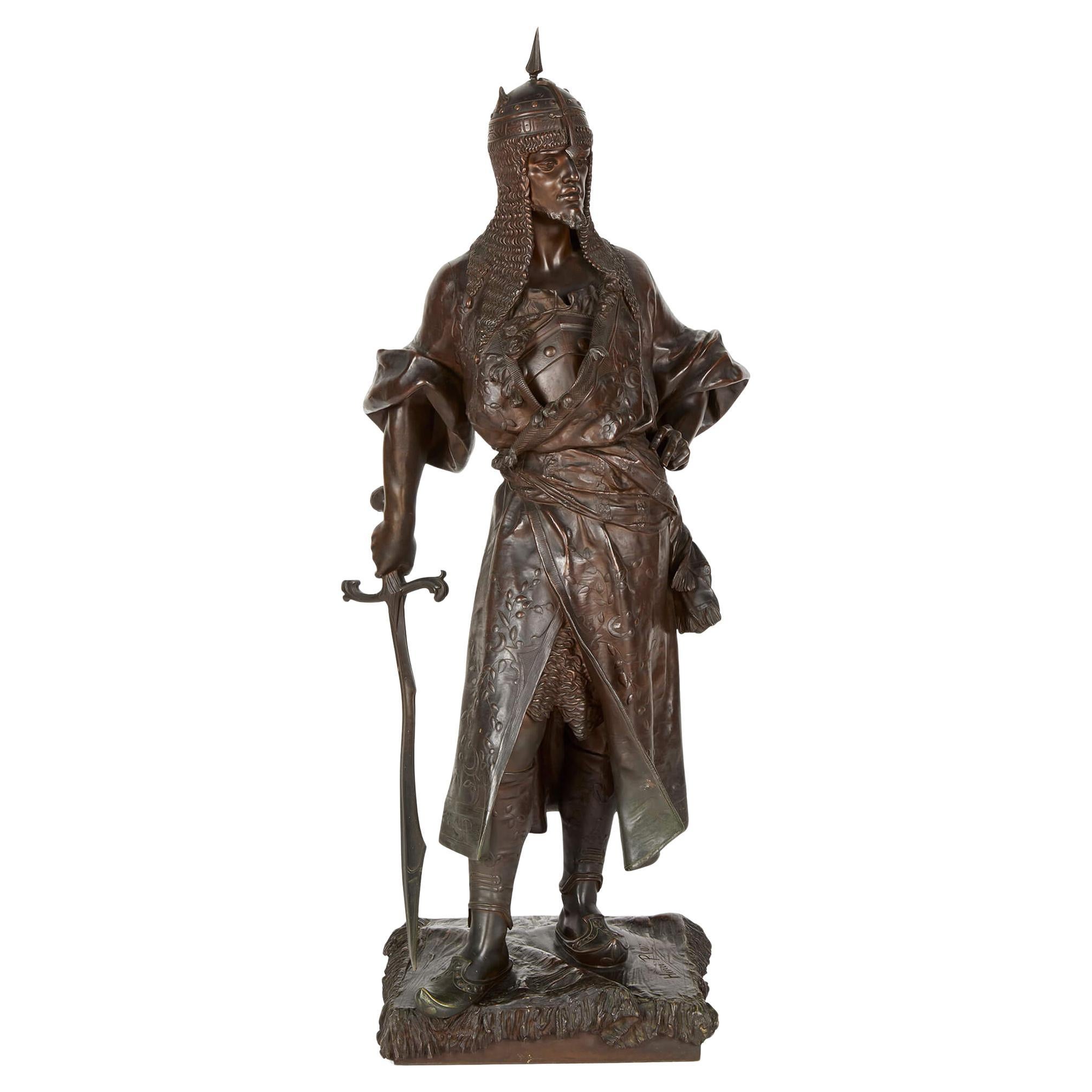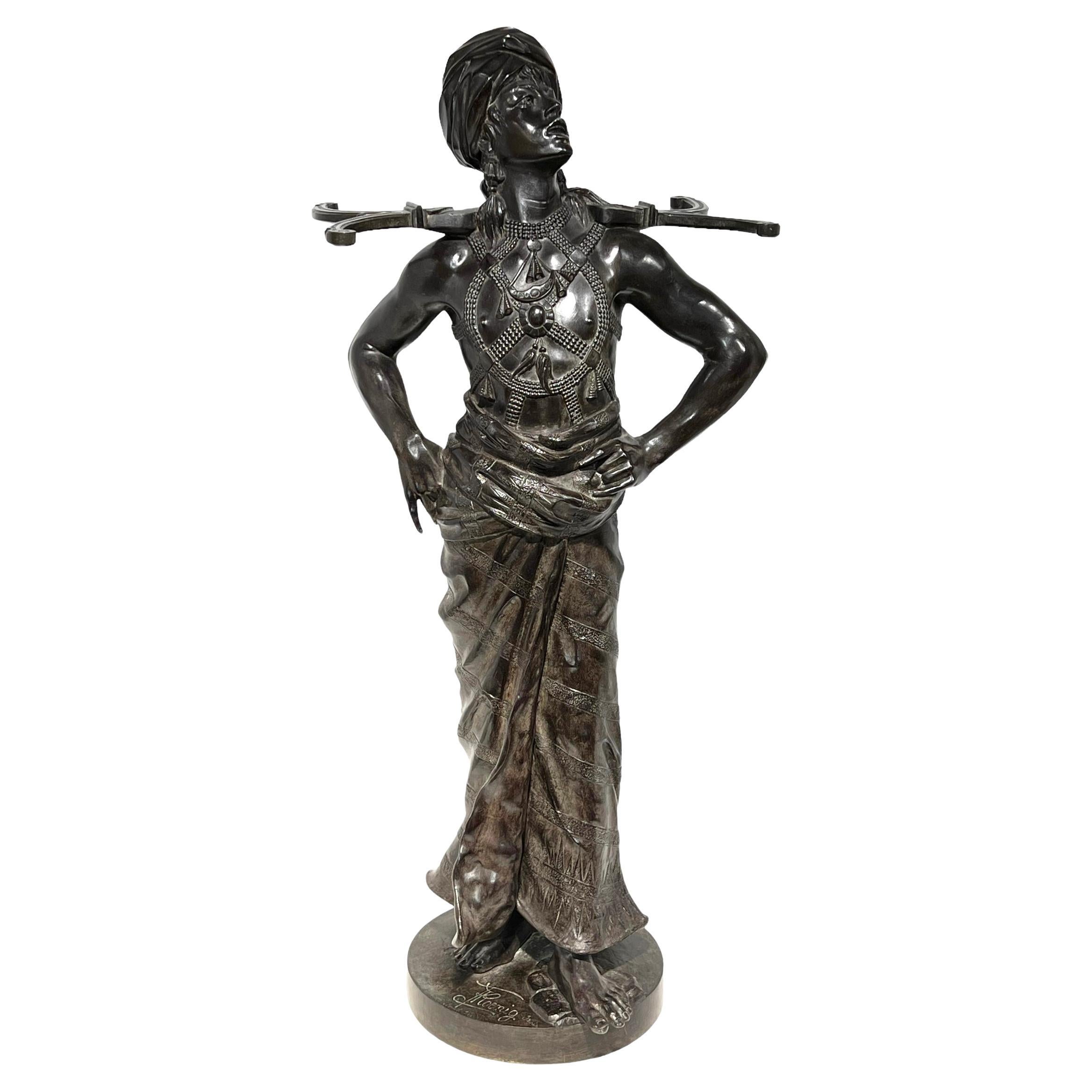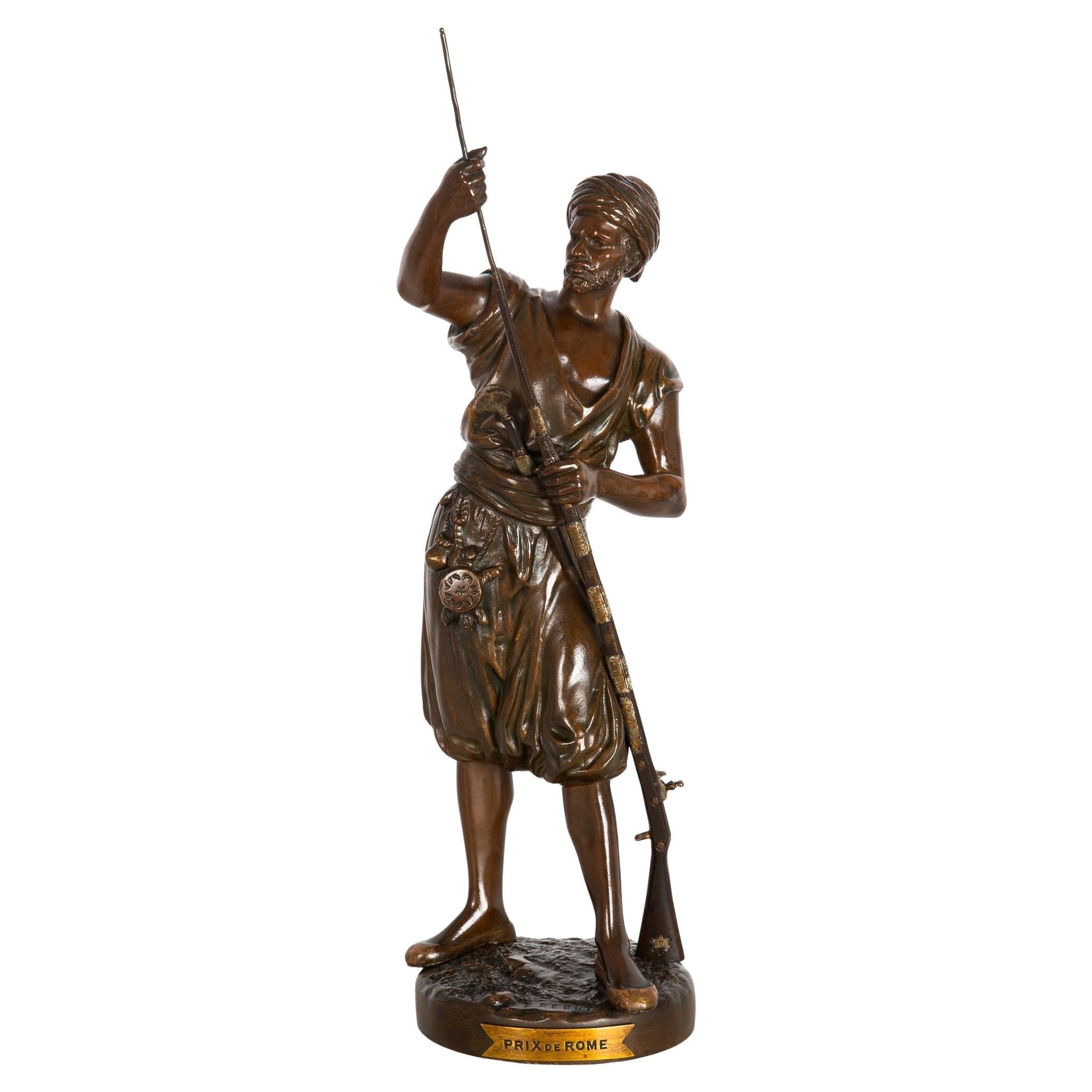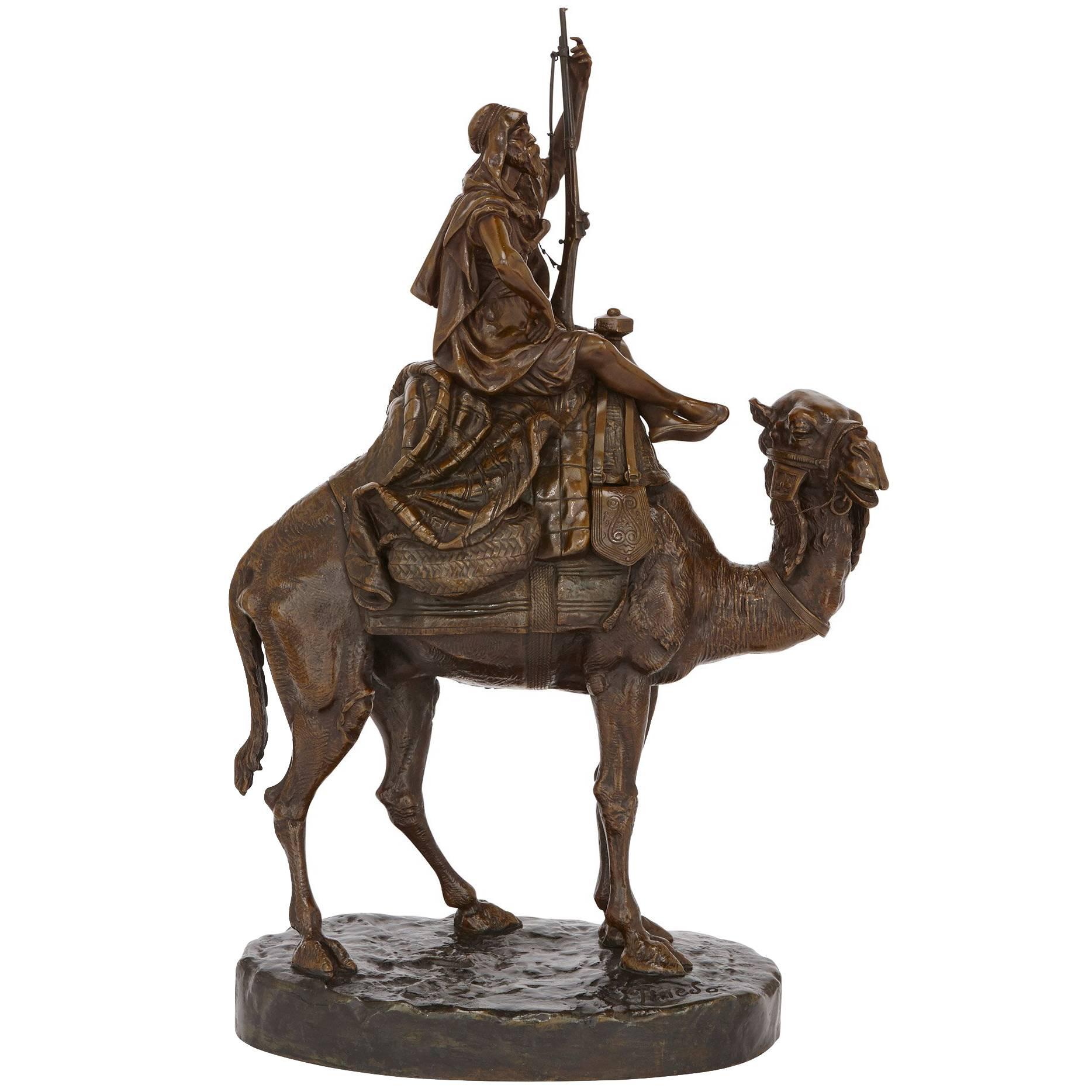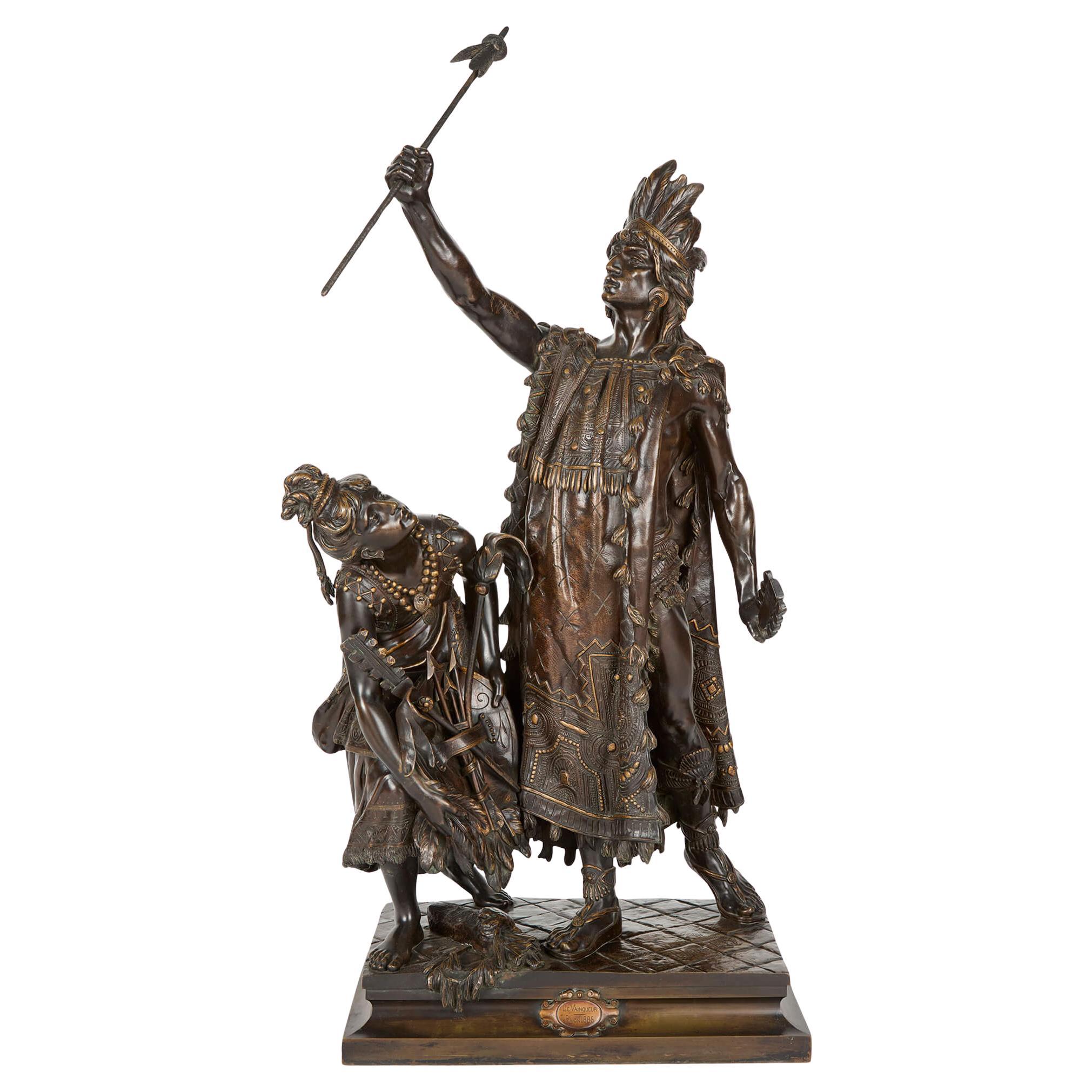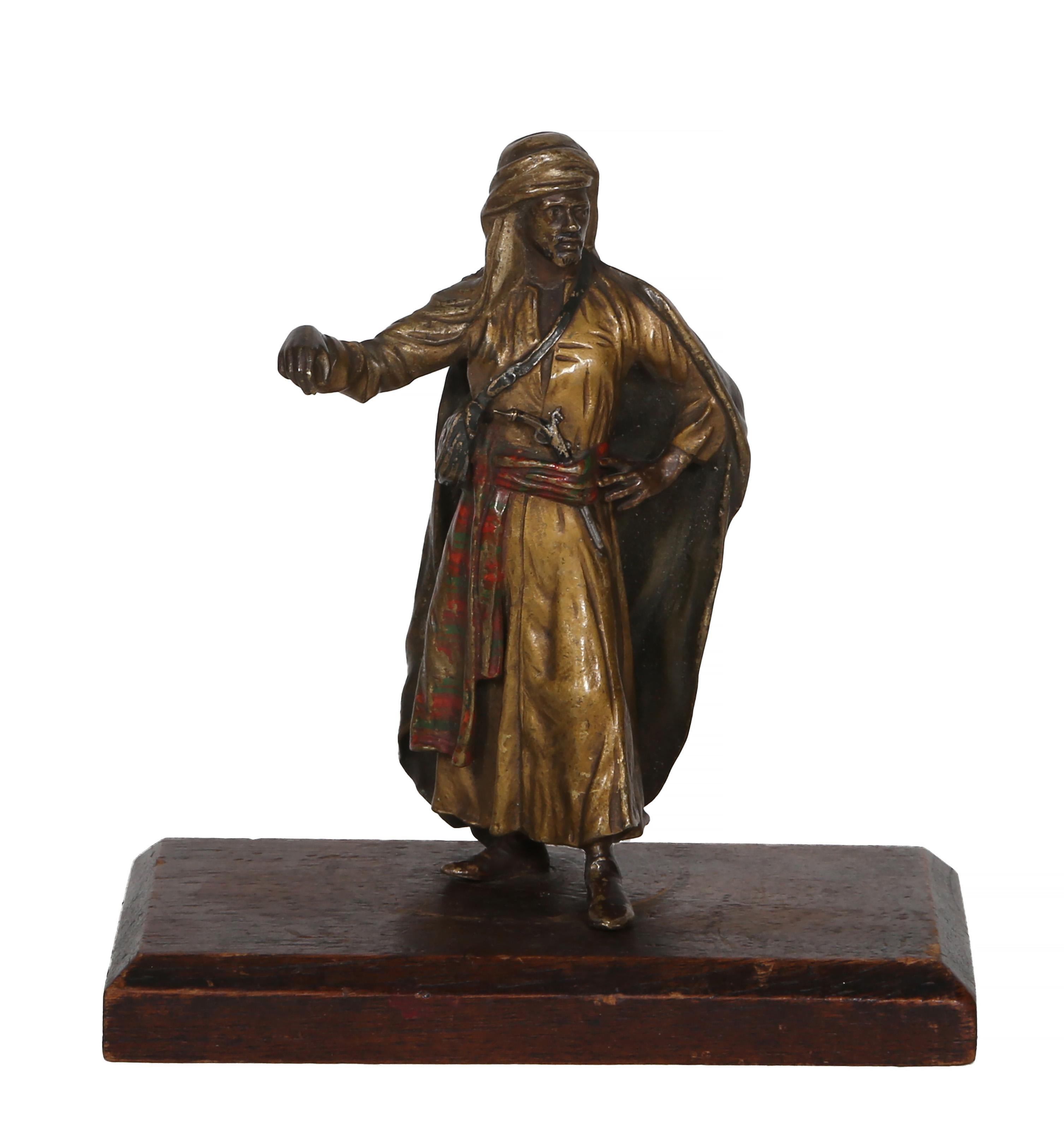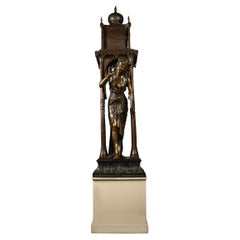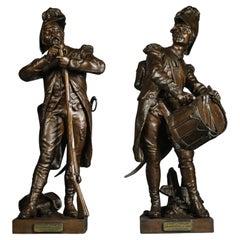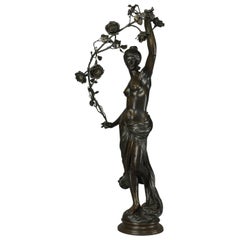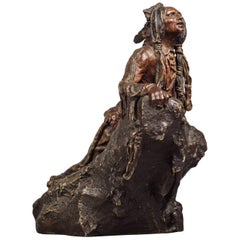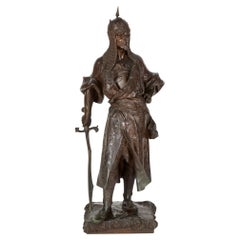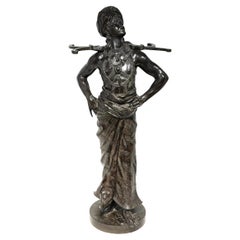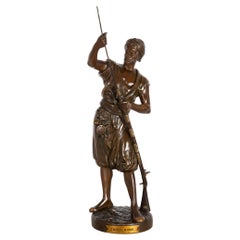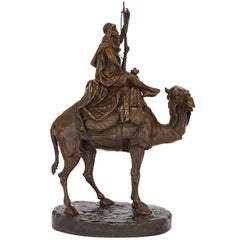Items Similar to Large Multi-Patinated Bronze Figure of an Arab Warrior by Henri-Honoré Plé
Want more images or videos?
Request additional images or videos from the seller
1 of 5
Large Multi-Patinated Bronze Figure of an Arab Warrior by Henri-Honoré Plé
$71,216.81
£52,000
€61,093.62
CA$99,885.13
A$109,547.48
CHF 56,498.22
MX$1,308,637.34
NOK 716,569.28
SEK 672,223.29
DKK 456,414.28
About the Item
A Large and Important Multi-Patinated Bronze Figure of an Arab Warrior by Henri Honoré Plé.
Signed Henri Plé to the base.
The figure is finely modelled as an Arab warrior, with sword drawn and crescent tipped standard held aloft, with a rich multi-patinated patina heightened with gilding.
French, Circa 1880.
Henri Honoré Plé (1853 - 1922) studied under Gérault and Mathurin Moreau, and worked as a painter and sculptor of portraits and bas-reliefs. He exhibited at the Salon from 1877 onwards winning an honourable mention in 1879 before going on to receive a bronze medal at the Paris 1900 Exposition Universelle.
Bibliography:
Forrest, Michael. Art Bronzes, Schiffer Publishing Ltd, (Pennsylvania), 1998.
- Creator:Henri Honoré Plé (Sculptor)
- Dimensions:Height: 55.12 in (140 cm)Width: 21.66 in (55 cm)Depth: 19.69 in (50 cm)
- Materials and Techniques:Bronze,Patinated
- Place of Origin:
- Period:
- Date of Manufacture:Circa 1880
- Condition:Wear consistent with age and use.
- Seller Location:Brighton, GB
- Reference Number:Seller: B681711stDibs: LU1028038443592
About the Seller
5.0
Recognized Seller
These prestigious sellers are industry leaders and represent the highest echelon for item quality and design.
Established in 1964
1stDibs seller since 2014
59 sales on 1stDibs
Typical response time: 1 hour
Associations
The British Antique Dealers' AssociationLAPADA - The Association of Arts & Antiques Dealers
- ShippingRetrieving quote...Shipping from: Brighton, United Kingdom
- Return Policy
Authenticity Guarantee
In the unlikely event there’s an issue with an item’s authenticity, contact us within 1 year for a full refund. DetailsMoney-Back Guarantee
If your item is not as described, is damaged in transit, or does not arrive, contact us within 7 days for a full refund. Details24-Hour Cancellation
You have a 24-hour grace period in which to reconsider your purchase, with no questions asked.Vetted Professional Sellers
Our world-class sellers must adhere to strict standards for service and quality, maintaining the integrity of our listings.Price-Match Guarantee
If you find that a seller listed the same item for a lower price elsewhere, we’ll match it.Trusted Global Delivery
Our best-in-class carrier network provides specialized shipping options worldwide, including custom delivery.More From This Seller
View AllAn Orientalist Lifesize Figural Bronze Statue, Attributed to Louis Hottot
By Louis Hottot
Located in Brighton, West Sussex
An Orientalist Lifesize Figural Bronze Statue, Attributed to Louis Hottot (French, 1834-1906).
Modelled as a lady in Ottoman dress standing beneath an Eastern style pagoda with minaret. Depicting as if answering a call and stepping forward in greeting.
France, Circa 1890.
This impressive figural group is a rare work in bronze attributed to the Orientalist sculptor Louis Hottot whose oeuvre is more readily associated with what was called ‘bronze imitation’, referring to sculpture in white-metal or, as it is known today, spelter. That this large statue is cast from superior and costly bronze is indicative of its rarity and importance. The Orientalist subject relates to paintings by Jean-Léon Gérôme (1824–1904), Ludwig Deutsch (1855–1935) Gustav Bauernfeind...
Category
Antique 19th Century French Figurative Sculptures
Materials
Bronze
Pair of Bronze Figures by Etienne-Henri Dumaige
By Etienne-Henri Dumaige
Located in Brighton, West Sussex
A Fine Pair of Bronze Figures Entitled 'Avant le Combat' and 'Apres le Combat', Cast from the models by Etienne-Henri Dumaige (1830 - 1888).
Signed H. Dumaige, with title plaquet...
Category
Antique 19th Century French Figurative Sculptures
Materials
Bronze
'Grand Nu Aux Feuillages', a Fine Patinated Bronzed Figural Group, circa 1900
By Alois Mayer
Located in Brighton, West Sussex
'Grand Nu Aux Feuillages', a fine patinated bronzed figural group by Alois Mayer.
German, circa 1900.
Signed 'A. Mayer'.
Alois Mayer (1855-1936) Was a German Sculptor who...
Category
Antique Late 19th Century German Figurative Sculptures
Materials
Bronze, Iron
Patinated Bronze Figure of a Native American Scout by Carl Kauba, circa 1910
By Carl Kauba
Located in Brighton, West Sussex
A fine patinated bronze figure of a Native American scout by Carl Kauba.
Austrian, circa 1910.
Signed in the cast 'Carl Kauba'.
The figure cast as an American Native scou...
Category
Early 20th Century Austrian Figurative Sculptures
Materials
Bronze
'Bonne Année, Bonne Santé', a Bronze Figure by Adolphe Maubach, circa 1900
By Adolph Maubach
Located in Brighton, West Sussex
'Bonne Année, Bonne Santé' -A fine patinated bronze figure by Adolphe Maubach.
French, circa 1900.
Signed 'Adolphe Maurbach' and bearing a gilt-bronze title plaque 'Bonne Anné...
Category
Antique Late 19th Century French Figurative Sculptures
Materials
Bronze
Pair of Patinated Bronze Egyptian Figures by Emile Louis Picault
By Émile Louis Picault
Located in Brighton, West Sussex
A Pair of Patinated Bronze Figures Of The Egyptian High Priest 'Pastophore' and The Egyptian Scribe 'Hierogrammate' By Emile Louis Picault (French, 1833-1915).
Each signed 'Picau...
Category
Antique 19th Century French Egyptian Revival Figurative Sculptures
Materials
Bronze
You May Also Like
Large Antique 19th Century Bronze Moorish Warrior Sculpture Figure Henri Plé
Located in London, GB
Large Antique 19th Century Bronze Moorish Warrior Sculpture Figure Henri Plé
French, 19th century
Height 111cm, width 54cm, depth 30cm
This striking late 19th-century bronze by Henr...
Category
Antique 19th Century French Moorish Figurative Sculptures
Materials
Bronze
19th Century Orientalist French Bronze Statue of Arabian Warrior
Located in New York, NY
Large patinated bronze figure of a proud Middle Eastern male. Signed in the cast, Koenig with Patent 1888 Paris. Apparently designed as a stick stand.
Category
Antique Late 19th Century French Figurative Sculptures
Materials
Bronze
Rare French Orientalist Bronze Sculpture Arab Warrior after Jean Didier Debut
By Jean Didier Debut
Located in Shippensburg, PA
JEAN-DIDIER DEBUT
French, 1824-1893
French Orientalist Model of a Janissaire Warrior
Polychromed and patinated bronze signed "E. Debut", sealed with editeur cachet "Bronze Ga...
Category
20th Century French Figurative Sculptures
Materials
Bronze
Large Orientalist Style Patinated Bronze Sculpture by Emile Pinedo
By Émile Pinedo
Located in London, GB
This stunning antique sculpture is finely crafted by Emile Pinedo, who was a master craftsman in creating works of Fine bronze. He is particularly well-kn...
Category
Antique Late 19th Century Italian Figurative Sculptures
Materials
Bronze
Large Antique 19th Century Bronze Native American Warrior Sculpture Henri Plé
By Henri Honoré Plé
Located in London, GB
Large Antique 19th Century Bronze Native American Warrior Sculpture Henri Plé
French, 1885
Height 111 cm, width 54 cm, depth 30 cm
This dramatic bronze by Henri-Honoré Plé captures ...
Category
Antique Late 19th Century French Romantic Figurative Sculptures
Materials
Bronze
Soldier, Orientalist Bronze Sculpture by Franz Bergmann
By Franz Bergmann
Located in Long Island City, NY
Franz Bergmann, Austrian (1861 -1936) - Soldier, Year: circa 1900, Medium: Cold painted Bronze sculpture, Size: 5.5 x 3 x 2 in. (13.97 x 7.62 x 5.08 cm)
Category
Early 1900s Romantic Figurative Sculptures
Materials
Bronze
More Ways To Browse
Bas Relief Portrait
Henri Honore Ple
Henri Ple
Henri Ple Sculpture
Plaster Torso
Reclining Nude Sculpture
Rodin Furniture
Sculpture Vintage Nude
Tall Figure Sculpture
Thiebaut Frered
Antique Bronze Foundry Marks
Art Nouveau Bronze Female
Art Nouveau Plaster Sculpture
Articulated Mannequin
Carved Stone Relief
Celestial Sculpture
Chiparus Bronze Dancer
Clay Female
